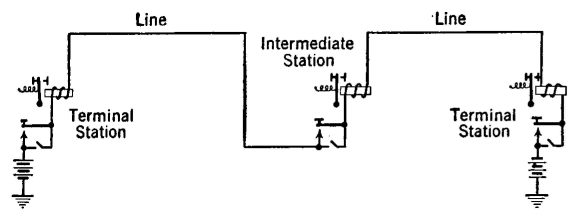| Electrical Communication is a free textbook on the basics of communication technology. See the editorial for more information.... |

|

Home  Telegraph Systems Telegraph Systems  Neutral Direct-Current Telegraph Systems Neutral Direct-Current Telegraph Systems |
|||||






|
|||||
Neutral Direct-Current Telegraph SystemsWith neutral direct-current systems, signal impulses of either polarity and zero-current spacing intervals are employed.2 They are often called single-current systems, because, in sending a message, current flows in one direction only. Two types of systems have been developed: first, the open-circuit neutral, or single-current, system which is used in short "local loops," or circuits; second, the closed-circuit neutral, or single-current, system which has had wide use for main-line circuits.
The open-circuit neutral system, the oldest and simplest of all types, is shown in Fig. 1. Current passes over the line only when a message is being sent; no current flows when the line is idle. When the transmitting key at any one of the stations is depressed, the battery at that station is connected to the line and current flows as long as the key is closed. This current energizes the electromagnets at the other offices, and the sounders respond. The closed-circuit neutral system is shown in Fig. 2. When a station is not sending, the switch at that station, and all other stations as well, is closed and current flows through the line. When a station desires to send, the switch at that station (only) is opened and the key is operated manually in accordance with the Morse code. Dots and dashes separated by spaces are sent along the line. Thus, with the closed-circuit system, current flows at all times excepting when spaces are made. If, during the transmission of a message, one operator wishes "to break" the circuit2 to send a message he can do so by opening his switch. All sounders cease to operate when the circuit is opened, and the operator, formerly sending, then closes his switch and waits for the message from the station desiring to send.
The open-circuit arrangement is more efficient from an energy standpoint because current flows only when the circuit is closed. However, as seen from Fig. 1, a battery is required at each station, and this cost usually offsets the additional energy cost of the closed-circuit method. In some closed-circuit installations as many as 30 or more intermediate stations have been connected in one line.
|
|||||
Home  Telegraph Systems Telegraph Systems  Neutral Direct-Current Telegraph Systems Neutral Direct-Current Telegraph Systems |
|||||
Last Update: 2011-05-30



